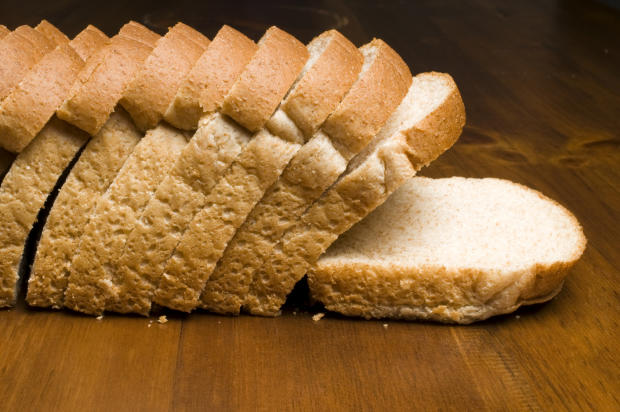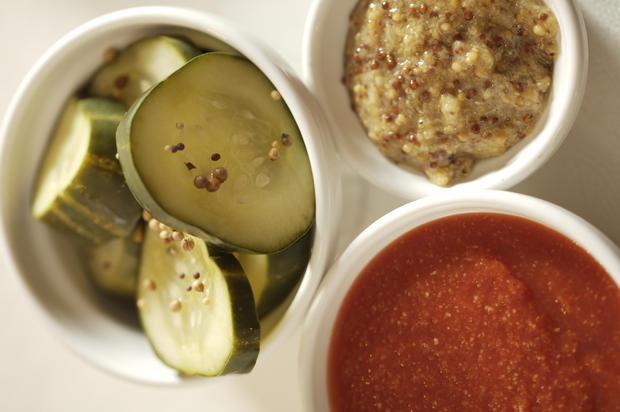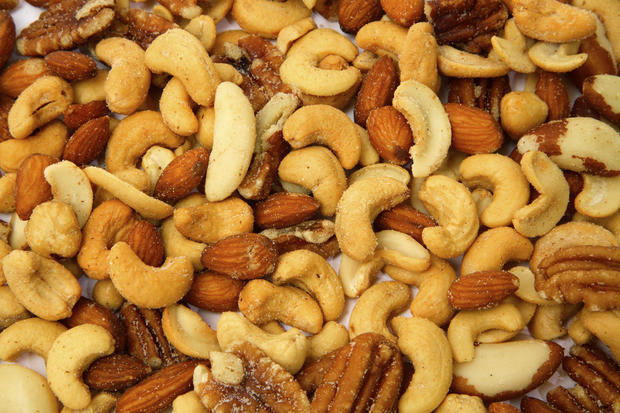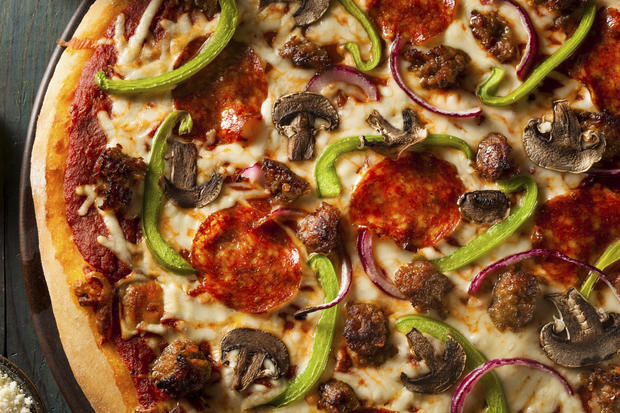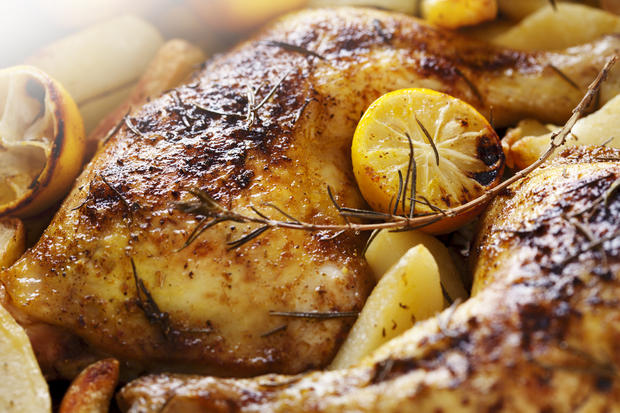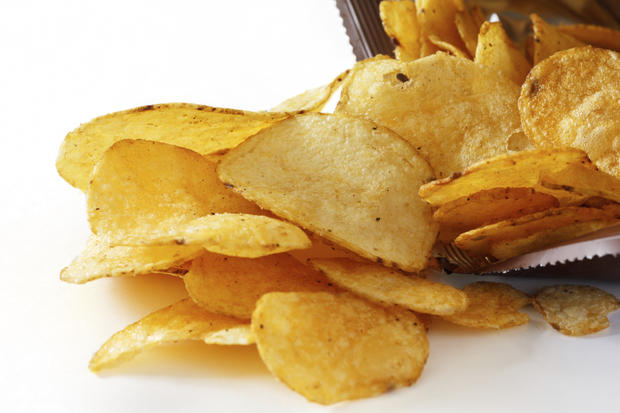10 sneaky sources of too much salt in your diet
Despite many previous warnings, a new report from the Centers for Disease Control and Prevention says Americans still eat way too much salt.
Ninety percent of children and 89 percent of adults consume more than the recommended 2,300 milligrams (about a teaspoon) of sodium a day, according to the latests findings from the 2009-2012 National Health and Nutrition Examination Survey (NHANES).
Our relentless love of salt is putting us at risk for high blood pressure and other health problems, warned CDC Director Dr. Tom Frieden.
"The finding that nine of ten adults and children still consume too much salt is alarming," Frieden said in a statement. "The evidence is clear: too much sodium in our foods leads to high blood pressure, a major risk factor for heart disease and stroke. Reducing sodium in manufactured and restaurant foods will give consumers more choice and save lives."
The CDC recommends even less daily sodium for certain groups: No more than 1,500 milligrams a day for adults over 51, African-Americans and adults with prehypertension and hypertension because they're at a greater risk for stroke and heart disease.
There are lots of ways to reduce the excess salt on our plates, said American Heart Association president Dr. Mark Creager, but the answers aren't always obvious. High levels of sodium can be found in some processed foods that don't taste particularly salty. Certain meals can pack more salt than you need in a whole day, and even foods we think of as "healthy" may be sabotaged by salt.
Click through to see 10 super-salty foods you should reduce or cut out altogether for your health, and the health of the kids in your life.
Breads
A lot of people eat bread a few times a day - with eggs for breakfast, on sandwiches at lunch, and slices at dinner - but the sodium in bread can really add up, cardiovascular disease specialist and American Heart Association president Dr. Mark Creager told CBS News.
"People often don't recognize that breads are loaded with salt, particularly commercial brands. It's put there for taste. If you eat a lot of bread, you're consuming a lot of salt," said Creager, who is also director of the Heart and Vascular Center at Dartmouth-Hitchcock Medical Center in Lebanon, New Hampshire.
A slice of Pepperidge Farm Farmhouse Hearty White bread, for example, contains 240 milligrams of sodium. Their whole grain versions still contain sodium, but a lower amount per slice.
Cold cuts
Cured deli meats are packed with sodium, and deli cheeses can be, too, said Lenox Hill Hospital nutritionist Sharon Zarabi.
For sandwich lovers, try to balance out, she told CBS News.
"If you know you're having luncheon meats, cut back on cheese and salty condiments, and add more vegetables for flavor," said Zarabi.
Go with an open-faced sandwich to reduce the sodium in the bread, or try a lettuce wrap instead.
Condiments
Pickles, olives, soy sauce all pack a sodium punch, said Sharon Zarabi, a nutritionist at Lenox Hill Hospital, in New York.
If you can't live without your dill pickles, rinse them in water before eating to reduce some of the sodium on the outside. Same with olives and other salty, preserved condiments.
Soy sauce has about 800 milligrams of sodium per tablespoon. Even low-sodium soy sauce still contains large amounts. When you're out having sushi, dilute your soy sauce with water, recommends, Zarabi. Or switch it out with lemon juice, which still provides a nice flavor kick with the sushi, she said.
With salad dressings, try the "dip and spear" method, recommends Dana Hunnes, senior dietitian and adjunct assistant professor at the Fielding School, at Ronald Reagan-UCLA Medical Center, in Los Angeles. "If eating a salad, put dressing on the side, dip your fork tines in the dressing and then spear the salad or vegetable. You still get the flavor without all the sodium and fat," she said.
"Diet" foods
Diet companies that package frozen meals and other foods to help people lose weight often focus on reducing calories and fat content, but sodium content in these products may be high to help boost flavor.
Sauces on broccoli or other "healthy" vegetables and lean meats, even if low in calories and fat, increase the salt content of a seemingly diet-friendly dish.
Zarabi said some weight-loss food makers have started to offer lower salt "steamed" selections, as an alternative.
Nuts
Nuts have many health benefits, but they can be very heavily salted. "It's a healthy fat, but you have to watch out for sodium," Zarabi said.
Look for nuts labeled unsalted, lightly salted, or low sodium. "Sometimes when I'm desperate for a snack, not everywhere sells unsalted nuts. I rub off the salt with a napkin and take off the crystals," she said.
Pizza
Pizza can be a real salt bomb because it tends to contain three sodium-heavy ingredients: cheese, bread, and prepared tomato sauce. Not to mention pepperoni, anchovies, olives, and other salty toppings.
Prepared tomato-based products, such as pasta sauces and tomato juice, are loaded with salt, said Lenox Hill Hospital's Sharon Zarabi.
One way to add flavor to pizza without adding salty prepared tomato sauce is to use fresh tomato slices. Grilled or broiled vegetables can be tasty toppings, too, said UCLA nutrition expert Dana Hunnes. "The caramelization gives a nice, sweet and tender flavor."
Hunnes said you can always make your own fresh tomato sauce with fresh or canned no-salt tomatoes, fresh basil, onions, garlic, oregano, thyme, a dash of balsamic vinegar, and then let it simmer
If there's no time to cook and you are choosing between brands of prepared sauce, read the labels and go for the one with less sodium, she said.
Poultry
Chicken, turkey and other poultry - even in their natural state - contain sodium, said Dr. Mark Creager, president of the American Heart Association.
"In and of itself, they have a high salt content, but if people prepare them in brine and add salt before roasting, sodium goes up even higher," he said.
Instead of adding salt before you cook, try seasoning with herbs instead. "Using fresh basil and other fresh herbs really packs a flavor punch,"said UCLA nutrition expert Dana Hunnes.
Keep an eye on the labels of prepared chicken nuggets and other read-to-serve poultry products - they're usually high in sodium, too.
Processed and packaged foods
Flavored potato chips, movie popcorn, even cereals - anything that comes in a box, can, or from a factory and that is not in its natural form anymore tends to have a higher sodium content, said Lenox Hill Hospital diet and fitness expert Sharon Zarabi.
"Potatoes become potato chips, flour becomes crackers, a grilled chicken breast becomes chicken tenders. Taking something from the farm and making it into a dish, an item, companies add salt," said Zarabi.
Kids are especially vulnerable to this category of salty staples. "Kids eat a lot more processed food altogether. Its' quick, easy, tastes good and the products are marketed to kids," she said.
The CDC report said children should be getting no more than 2,200 milligrams of sodium a day in their diets, yet it found that boys ages 9 to 13 consumed another 1,100 milligrams of sodium above that level, and girls overshot the mark by 800 milligrams.
"I was shocked by the amount of sodium young children are eating," said Dana Hunnes, senior dietitian at Ronald Reagan-UCLA Medical Center.
"Become a label reader," Zarabi advises kids and adults. Compare similar dishes or different brands of canned and packaged foods. Sometimes the same product, a can of beans by two different companies, for example, can have very different sodium levels, she said.
Restaurant meals
The CDC says more than three quarters of the sodium in the American diet comes from processed and restaurant foods, which can make it hard to cut down on sodium, even if you're trying.
Some larger efforts are being made to reduce sodium in restaurant foods. A first-of-its kind New York City rule recently began requiring chain restaurants to start putting a saltshaker symbol on highly salty menu items that top the recommended daily limit of 2,300 milligrams - about a teaspoon - of sodium.
American Heart Association president Dr. Mark Creager said restaurant waiters and chefs are usually accommodating if you ask about ordering a heart-healthy meal, or dishes with low or no salt.
"Even when you go out to well-established restaurants, chefs tend to use salt. So I tend to order meals that are heart-healthy, those that I know have low salt. And I will ask my server to ask the chef to reduce the amount of salt, especially in sauces, which generally can be higher in sodium," Creager said.
Other ways to reduce sodium when eating out: Split a saltier dish with a friend and order a side salad or steamed or grilled vegetables to round out the meal, suggested UCLA nutrition expert Dana Hunnes.
Soup
When it comes to soups, homemade is best, Hunnes said.
Cups of noodles and canned soups generally have a lot of salt, unless you choose one labeled low-sodium.
"Cook from scratch as much as possible. Use fresh, unadulterated ingredients and use creative methods of preparation to reduce or eliminate the salt," said Hunnes. "Make soups from scratch, or seek out low-sodium versions."
Going low-salt doesn't mean a tasteless future. It takes 20 to 30 days for your taste buds to acclimate to the new flavors, said Hunnes.
"But, once you do, you will taste fruits, vegetables, grains, for how they really taste. You will taste their natural sweetness, nuttiness, textures, flavors. When you try some of the foods you used to eat, all you will taste is salt. So, I usually tell people the best and easiest way to reduce their sodium intake is to just cut it out," she said.

